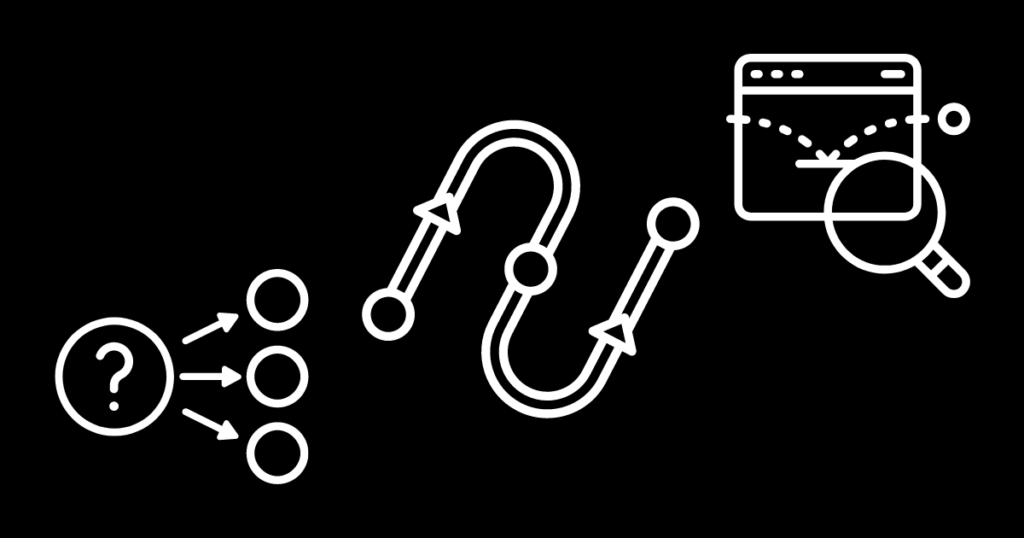Learn 10 reasons your bounce rate is high on your website, as well as when a bounce rate is “good” and “bad” by reading on! Addressing these pain points will keep visitors on your website for longer, viewing more pages, and converting to paying customers.
But first, you have to understand this analytic and why it’s important.
What is a Bounce Rate?
“Bouncing” is visiting your site, but leaving after only viewing one page. Typically people consider a high bounce rate (percentage of viewers leaving after 1 page) bad, but it’s important to note that isn’t always the case. There can be a lot of good, user-friendly reasons your bounce rate is high, depending on the type of website you run.
Sometimes people find what they’re looking for on the first page and have no need to look further. For instance, if they’re looking up a tracking number, stock info, or announcement pages, they may have the page bookmarked to check in on periodically. There is no reason for them to browse your site and look further in those instances because they got what they’re looking for on the one page they have saved.
If your site functions as one of the above scenarios, a higher bounce rate may indicate user friendliness and usability of your site.

You should be able to see in your analytics a bounce rate for your overall site. You should also be able to view a bounce rate per page, which should give you greater insight. Eventually you’ll find patterns – for instance if you release announcements on Tuesdays, you may find that page has a high bounce rate on Tuesdays, affecting your overall bounce rate throughout the week.
However, many people stumble across the homepage of your site, and the goal is typically to have them stick around, click through your pages, and ultimately make a purchase or submit a contact form. Learning the reasons your bounce rate is high will help you evaluate the strengths and weaknesses of your page.
What is Considered A Good Bounce Rate?
This is why the goal isn’t to have a 0% bounce rate in any circumstance. A ‘good’ bounce rate varies from industry to industry, and varies further still depending on type of website and specific goals.
However, there are typical guidelines that are good to live by when evaluating the reasons your bounce rate is high (or low).
E-commerce sites have an end-goal of purchases made, so a bounce rate between 20%-40% is considered good. That means 60%-80% is sticking around to further explore your site, increasing your odds of a transaction made.
Content-based websites such as blogs or news sites often have higher bounce rates because people visit a specific page to get the content they want, and then leave. For these types of sites, a bounce rate of 40%-60% is acceptable. However, efforts should always be made to engage visitors further (such as linking to relevant articles).
Landing pages and single-page websites obviously accrue a high bounce rate. These can be event-registration pages or lead generation forms, or small businesses that don’t have a need for multiple pages. For these types of pages, focus on conversion rather than page clicks. A bounce rate below 70% is pretty decent for these types of sites. However, it’s important to analyze the conversion rate to gain a broader picture of the overall effectiveness of the page.
5 Design Reasons Your Bounce Rate is High
Some of the reasons your bounce rate is high have to do with the design of your site. A successful designer will build your site with ease-of-use and natural flow in mind to encourage users to visit more than one page.
The good news is that each of the design reasons for a high bounce rate are fixed fairly easily!
1) Slow Load Time
If a website takes too long to load, visitors may become frustrated and abandon it. Today’s consumers expect lightning fast and responsive websites. Delays in loading are a surprising and overlooked reason your bounce rate is high.
2) Poor Design/User Experience
A website that is visually unappealing or difficult to navigate can discourage visitors from exploring further. Cluttered layouts, confusing menus, or confusing navigation can be a huge reason your bounce rate is high.
3) Lack of Mobile Optimization
With increasing use of smartphones and tablets, websites must be optimized for mobile devices. If a website is not mobile-friendly, it makes for a poor user experience, difficulty navigating, and ultimately high bounce rates.
4) Ineffective Landing Pages
If a visitor arrives at a landing page that does not meet their expectations or fails to deliver what was promised, they will leave immediately. A clear and compelling landing page is essential to converting visitors into engaged users.
5) Technical Issues and Errors
Broken links, error messages, and other technical issues can frustrate users and drive them away. If your website doesn’t function properly, visitors are unlikely to stay (or return in the future).

5 Content Reasons Your Bounce Rate is High
Consumers do not want to have to search and search for the information they want. In fact, they simply won’t do it. Accurate, fair, and honest information needs to be on any given page, delivering value to the consumer every time.
Your content should be updated regularly to be relevant and current. You don’t have to update your content all at once, though. Update old blog posts, rebuild your site, or revamp your advertising method a little at a time for a more enjoyable user experience.
1) Irrelevant/Low Quality Content
Visitors arrive at a website expecting certain information or products. When they find content that is unrelated, unhelpful, or of low quality, they will leave immediately. Relevant and valuable content is crucial for engaging visitors and keeping them on the website.
2) Intrusive or Excessive Advertising
Pop-ups ads, auto-playing videos, or an overwhelming number of advertisements are annoying and disruptive to the viewing experience. It adds a layer of difficulty in navigation (where is that sound coming from?!) is an overlooked reason your bounce rate is high. They can and will find this information elsewhere if your site is obnoxious.
3) Lack of Trust or Credibility
If a website appears untrustworthy or lacks credibility, visitors will bounce. This can be due to factors such as poor security, fantastical claims, lack of contact information, or lots of negative reviews.
4) Lack of Relevance/Mismatched Intent
Sometimes visitors arrive at a website through search engine results or external links, only to find this isn’t what they were looking for. Obviously they will bounce in search of more relevant pages. A clear description of your pages through meta descriptions and slugs avoid misrepresented search results.
5) Competing Distractions
In today’s world of information-at-our-fingertips, there’s no such thing as a corner on the market. There are tons of distractions and competing sites offering similar information. Your website needs to captivate attention and engage visitors quickly enough to take them away from other priorities for long enough to see what you’re offering.
The Bottom Line
There are so many possible reasons your bounce rate is high. However, it’s important to evaluate the type of page they’re bouncing from, the type of website you offer, and your acceptable bounce rates to know if that’s truly a bad thing. From there, you can address your bounce rates through evaluating design problems and content problems to keep users on your site for longer. If you need help with your analytics, or need a rebuild altogether, you know where to find us!